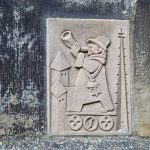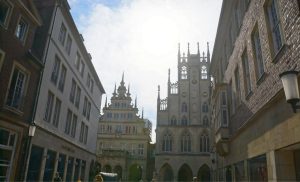St. Paul’s Cathedral is one of the most important church buildings in Münster and a landmark of the city. It stands in the middle of the old town on the Domplatz. During our first visit to Münster, we unfortunately did not have time to visit St. Paul’s Cathedral. On our second visit to the city, we were now fortunately able to make up for it.
St. Paul’s Cathedral: architectural history
The present cathedral is already the third cathedral of the Münster diocese. The two previous buildings were demolished.
The building history of the present cathedral begins around 1192, when the bishop of the time had the Romanesque west building erected at his own expense. At that time the second cathedral was still standing and the west building was added here. After the demolition of the second cathedral, the west building was preserved and integrated into the third cathedral.

The foundation stone of today’s cathedral was laid by the then bishop in 1225. After about 40 years of construction, the church was finally consecrated. Numerous reconstruction measures, but also destructions during the Anabaptist riots and wars changed the image of the cathedral again and again. After the Second World War, the almost destroyed cathedral was rebuilt from 1946 to 1956. Except for the destroyed ceiling paintings and the west portal, it was possible to create an almost original reconstruction.
Short tour of St. Paul’s Cathedral
My first glance when I enter the cathedral falls on the former west portal in St. Paul’s Cathedral. Here, after the Second World War, a plain wall with 12 circularly arranged round windows was created. In the center of the circle are four windows arranged into a square. I am thrilled by the simplicity of the wall and the optical impressions one gets here. I can’t really understand the people of Münster, who largely reject this wall design and have coined terms like “God’s dial” in reference to the telephone dial for the wall. I like it!

I find the windows in the choir ambulatory and in the chapel crown especially beautiful. The 17 stained glass windows are defined by symbolic biblical scenes. The play of light of the sun falling through is simply beautiful.
St. Paul’s Cathedral is a very pleasant church building in my eyes. There are some really beautiful statues and chapels, but still it is not “overloaded” and bludgeons the visitor with its splendor. For me, just right to feel comfortable in it.

Astronomical clock
For me particularly impressive, the astronomical clock in the cathedral of Münster. As early as 1408, the first astronomical clock could be seen in the cathedral. However, this was smashed during the Anabaptist riots in 1534.
Only a few years later, the people of Münster were able to enjoy a new clock. This was redesigned several times over the years due to calendar reforms, clockwork renovations and optical-artistic changes. In 1927, the astronomical clock was almost removed, but fortunately it could be preserved. During the war, the clock was stored and thus saved from destruction. Since 1951, it has been back in St. Paul’s Cathedral in Münster and shows the time.

In all religions, priests had the task of setting the dates for religious festivals. In doing so, they had to be able to calculate the exact position of the full moon, for example. An astronomical clock helped them to do this. Astronomers helped to adjust the numerous settings of the clocks by their precalculations.
It is said that once there were a good 1000 astronomical clocks. Unfortunately, only a few of them are still preserved, and one of them is in Münster. The clock in the cathedral of Münster has a considerable size, it is over 7 meters high, and beautifully painted.
We stood in front of the clock for a while, trying to understand its complexity. Fortunately, you can buy a leaflet that helps you with this. I don’t want to go into detail here, just note that you can read the time, the signs of the zodiac, the cardinal directions, the position of the stars in the sky and the date, among other things. I found all this quite confusing and would have to deal with it properly to come to the correct reading result here.

Since I am also fortunately not dependent on the specifications of the astronomical clock, I could enjoy the beautiful details of the individual elements. I especially liked the small figures that are on the left and right above the clock. I did not know, for example, that Chronos is the god of time – shown here together with Death.
A visit to St. Paul’s Cathedral in Münster is definitely not to be missed.

Address:
Domplatz 28,
48143 Münster
Opening hours:
Sunday and holidays: 6.30. – 19.30
Monday – Saturday: 6.30 – 19.00














Leave a Reply